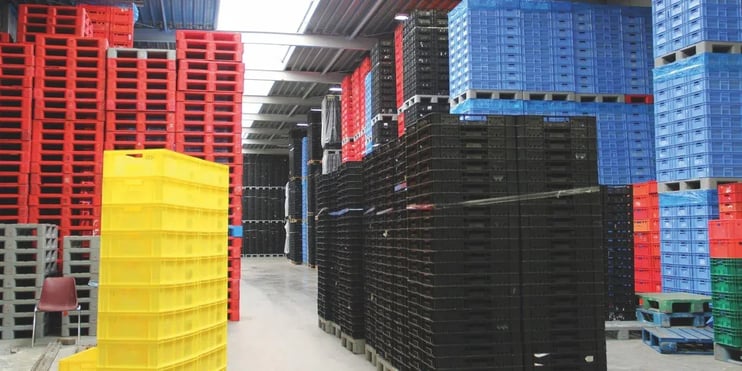The influence of the type of crate on which crate washer to select

You work with a certain type of crate within your company. Or perhaps with several different types of crates. What these crates look like exactly is important when making a choice for a crate washer.
The EKW crate washers from Elpress are suitable for crates with maximum dimensions of 600 x 400 x 300 mm (length x width x height). The crate washing machines have a modular structure and are therefore suitable for cleaning various types of load carriers. As a result, our standard washing systems can often be made to the client’s specifications for an attractive investment. The plastic click nozzles in the rinsing arms and the guides in the washer can also be adjusted to suit the type of crate.
Type of crate
Load carriers come in various (standard) versions.
Examples of commonly used load carriers:
- CBL-crate (sometimes called a fresh container): a crate with openings and indentations that is mainly used for fruit and vegetables.
- E2-crate: a closed crate for meat and poultry.
- Fish-crate: a closed crate for fresh fish and shellfish.
Because of the openings in a CBL crate, it is possible that cleaning this type of crate can be more complicated than a closed E2 or fish crate. Therefore a longer washing process may be necessary. Of course, it is also dependent on the type and degree of soiling.
Uniformity
The above-mentioned crate types come in differing shapes and sizes. Although the crate washing machine's guides can be adjusted, in practice this is quite difficult. Elpress advises you to use one type of crate as much as possible. So if you still need to purchase load carriers, we recommend that you choose as few different types as possible. If you already work with multiple crate types, it is best to sort them as much as possible before washing, in order to achieve the best results.
Wash alignment
The Elpress crate washers have a standard track width of 600 or 400 millimetres. The size of the crate determines whether it is washed lengthwise or sideways. Normally the crates enter the washer sideways, so with the long side in front. If the length of the crate is wider than the track width, then the crate can be washed lengthwise (so the short side goes into the washer first). This naturally effects the capacity of the washer. Fewer crates can be washed per hour.
When the crate has indentations on the long side, it may be necessary to turn it a quarter turn and to wash it lengthwise, so that it runs properly over the washer guides.
Utensil washer
In general, the crate washer is set to the type of crate you wash the most. Do you have a smaller quantity of crates of a type that deviates completely from the most used crate, and that doesn't fit properly into the crate washer? Then you might consider washing this small number in a separate utensil washer. Elpress can advise you if this is an interesting option for you.
Check-list
Would you like to see clearly, quickly and easily, what you need to consider when buying a crate washer? Then please fill in the check-list 'Points to consider when purchasing a crate washer'.

.webp)




.jpg?width=600&height=300&name=eCIS-(4).jpg)
.jpg?width=600&height=300&name=eCIS-(2).jpg)